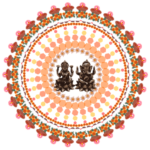Gotipua dance is such a unique dance form where masculine strength beautifully blends with feminine grace. In the term ‘Gotipua’, ‘Goti’ means ‘single’, and ‘Pua’ means ‘Boy’. This is one of the oldest dance forms in Odisha, a southeastern state of India. The Raghuraj village, near Puri, is renowned for its vibrant Gotipua dance troupes. Gotipua is a ritualistic dance form that is performed to please Lord Jagannath, an incarnation of Lord Krishna. It is mostly about acrobatic moves and takes a lot of flexibility to perform. The practice of this dance form is exclusive to young boys until they reach adolescence.
Origin of Gotipua Dance:
The Gotipua dance form originated from the centuries-old art of the Mahari Dancers. Long ago, a ritualistic dance form named Mahari was performed by Devadasis in the temples of Odisha. In around the 16th century, when the tradition of Devadasis came to an end, the Gotipua dance form was born. Dressing up as women, the young boy dancers carried forward this tradition, giving rise to the Gotipua dance.

The Mahari dancers were dedicated to Lord Jagannath. They daily performed the dance for Lord Jagannath in the temple. But, due to their menstrual cycle, the Mahari dancers couldn’t be able to perform throughout the month. According to some legends it was also a reason to replace them with boy dancers, and from then on, Gotipua began.
Makeup and Costume:

The boy dancers transform into graceful figures with a unique style. They apply a mixture of white and red powder on their face. A pattern made from sandalwood surrounds the Bindi placed on the forehead. Using broad strokes of Kajal, they give an elongated look to their eyes. The dancers do not cut their hair. They tie their long hair into a charming knot and adorn it with garlands of colorful flowers. Also, on the face, they apply special paintings that are different for each dance school.

The costume of these dancers has changed over time. Their classic costume includes ‘Kanchula’ and ‘Nibibandha’. Kanchula is a brightly colored blouse with shiny decorations. On the other hand, Nibibandha is an apron-like silk cloth that elegantly wrapped around the waist, like a ruffle encircles the legs. Some dancers still follow the age-old tradition of the Pattasari. Pattasari is a 13-foot-long piece of thin fabric that is worn tightly with equal lengths on both sides and knot at the navel. However, modern designs have made it easier to wear these garments.

Besides these, the Dancers adorn themselves with special beaded jewelry like necklaces, bracelets, armbands, and ear ornaments. Instead of nose-piercing jewelry, they opt for a painted design. They painted their palms and the soles of their feet with the vibrant red Alta. Their ankle bells jingle to the rhythm of their feet. All these elements hold a deep sense of sacredness.
Elements of Gotipua Dance:

Vandana:
The Gotipua dance performance begins with the Vandana, a heartfelt prayer. The dancers gracefully execute a three-step salutation. The first one, above their heads, is a tribute to the divine. The second, in front of their faces, is to pay honor to their Guru. And at last, they extend their hands towards their chests, expressing gratitude to the audience.
Sarigama:
This element of the Gotipua dance celebrates beauty and highlights the exceptional technique. The depictions of these dancers and musicians are found on the walls of numerous ancient temples.
Abhinaya:
The Abhinaya is like bringing songs and ancient poetries to life through dance and storytelling. It is all about beautifully expressing emotions and meanings. The performance of the dancers depicts the poetries related to Radha-Krishna. The faces of the dancers come alive with emotion, their eyes speak volumes and their hand gestures convey intricate meanings. It is just like watching a heartfelt love poem come alive on stage.
Bandha Nrutya:

Bandha Nrutya is the most fascinating aspect of Gotipua dance. The Sanskrit word, Bandha, refers to the complex and intricate body positions, involving different limbs. Thus, Bandha Nrutya is a presentation of acrobatic yoga postures that tell the stories of Krishna’s life. This is much the colorful paintings created by Pattachitra artists in Odisha. To become a skilled dancer, boys have to start learning this dance at the age of 5 or 6.
Here, we mention some Bandhas that are found in oral tradition –
i.Chira (welcome pose).
ii.Padmasana (lotus pose).
iii.Hansa (swan): It is a vehicle for maa Saraswati. It represents wisdom, grace, and beauty.
iv.Mayura (peacock): consider the sacred bird of Hindu mythology and feathers of Mayura adorn Krishna’s head.
v.Chara Mayura (grazing peacock): represents splendor and majesty.
vi.Keli Kadamba: A holy tree under which Krishna played.
vii.Garuda: Mythical eagle, a vehicle for Lord Vishnu.
viii.Kandarpa Ratha: Chariot of Kandarpa, god of love.
ix.Sagadi (wheel): represents the wheels of Lord Jagannath’s chariot.
x.Nauka (boat).
xi.Kaliyadalana: The defeat of Blacksnake by Krishna.
xii.Bakasura: One character of Mahabharata who was killed by Bhima.
People also Read:Bharatanatyam Dance – A Mesmerizing Journey of Classical Dance
Instruments:

During a Gotipua dance performance, several musical instruments accompany the dancers. That are – i) Mardala, a two-headed drum. (percussion instrument in Odisha). ii) Gini (small cymbals), iii) Harmonium, iv) Violin, v) Bansuri, and vi) one or two Vocalists.
Historical Evidence of Gotipua Dance:
Various Indian texts like ‘Abhinaya Chandrika’ and ‘Sangita Darpana’ offer insights into this dance form. Abhinaya Chandrika, a 15th-century text on Odissi dance, gives detailed concept of the movements of the feet, hands, standing postures, and so on. It also mentions more than 25 distinct Bandhas. On the other hand, Sangita Darpana, a 17th-century text on music and dance, guides the entire presentation style, providing a complete repertory.
The Gotipua dance not only keeps our history alive but also adds sparkle to India’s cultural beauty. This dance has greatly influenced present-day Odissi dance. Many legendary Odissi dancers like Kelucharan Mohapatra were Gotipua dancers at their young age. So, in the dazzling world of dance, Gotipua shines as India’s radiant gem.

